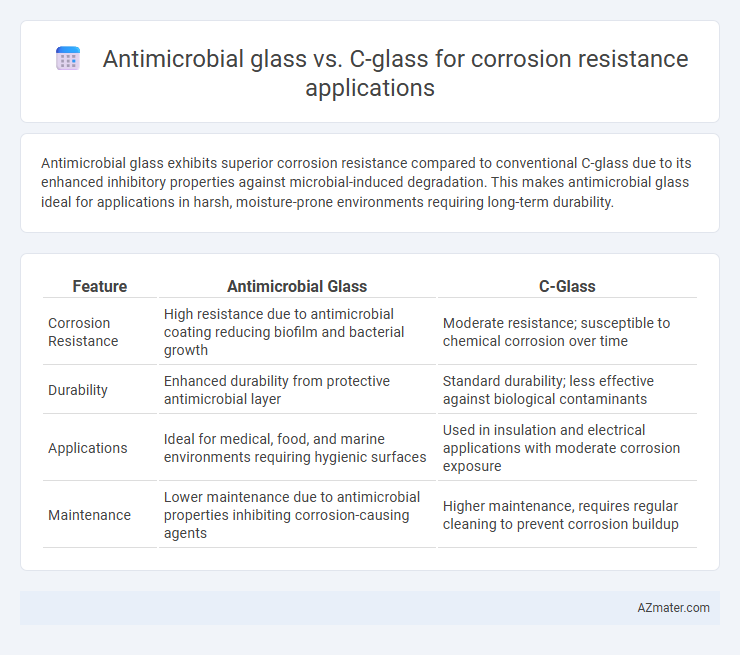Antimicrobial glass exhibits superior corrosion resistance compared to conventional C-glass due to its enhanced inhibitory properties against microbial-induced degradation. This makes antimicrobial glass ideal for applications in harsh, moisture-prone environments requiring long-term durability.
Table of Comparison
| Feature | Antimicrobial Glass | C-Glass |
|---|---|---|
| Corrosion Resistance | High resistance due to antimicrobial coating reducing biofilm and bacterial growth | Moderate resistance; susceptible to chemical corrosion over time |
| Durability | Enhanced durability from protective antimicrobial layer | Standard durability; less effective against biological contaminants |
| Applications | Ideal for medical, food, and marine environments requiring hygienic surfaces | Used in insulation and electrical applications with moderate corrosion exposure |
| Maintenance | Lower maintenance due to antimicrobial properties inhibiting corrosion-causing agents | Higher maintenance, requires regular cleaning to prevent corrosion buildup |
Introduction to Corrosion Resistance in Glass Materials
Corrosion resistance in glass materials is critical for ensuring durability and longevity in harsh environments, particularly in industrial applications. Antimicrobial glass offers enhanced resistance by incorporating metal ions such as silver or copper, which inhibit microbial growth and reduce surface degradation. C-glass, commonly used for fiberglass reinforcement, provides moderate corrosion resistance but lacks the antimicrobial properties that improve overall material performance in corrosive settings.
Overview of Antimicrobial Glass Technology
Antimicrobial glass technology integrates ions such as silver or copper into the glass matrix to inhibit microbial growth, significantly enhancing hygiene and surface protection. This technology offers superior corrosion resistance by preventing biofilm formation and reducing microbial-induced degradation compared to traditional C-glass, which lacks these antimicrobial properties. The enhanced surface durability and reduced maintenance requirements make antimicrobial glass ideal for environments prone to microbial contamination and corrosion challenges.
What is C-Glass? Composition and Standards
C-Glass is a type of fiberglass specifically designed for corrosion resistance in chemical environments, composed primarily of silica (SiO2) around 55-60%, with significant amounts of calcium oxide (CaO) and aluminum oxide (Al2O3) to enhance its chemical durability. It meets standards such as ASTM D578 and ISO 2078, ensuring consistent quality and performance in aggressive applications where resistance to acidic and alkaline environments is critical. Compared to Antimicrobial glass, C-Glass offers superior resistance to chemical attack, making it ideal for reinforcing structures exposed to corrosive substances.
Corrosion Resistance Mechanisms: Antimicrobial vs C-Glass
Antimicrobial glass incorporates metal ions such as silver or copper, which actively disrupt microbial cell membranes and inhibit biofilm formation, thereby reducing biochemical corrosion processes. C-glass, primarily composed of calcium aluminosilicate, exhibits superior chemical durability and resistance to acidic environments through its dense silica network and stabilization of the glass matrix. While antimicrobial glass targets biological corrosion by preventing microbial colonization, C-glass provides enhanced structural integrity against aqueous corrosion, making both materials suitable for different aspects of corrosion resistance applications.
Comparative Chemical Durability of Antimicrobial Glass and C-Glass
Antimicrobial glass exhibits superior chemical durability compared to C-glass due to its enhanced resistance to acidic and alkaline environments, making it more suitable for corrosion resistance applications. The incorporation of antimicrobial agents in the glass matrix improves its stability against aggressive chemicals, reducing degradation over time. In contrast, C-glass, while offering moderate corrosion resistance, tends to deteriorate faster under prolonged chemical exposure, limiting its effectiveness in harsh conditions.
Performance in Aggressive Environments
Antimicrobial glass exhibits enhanced corrosion resistance in aggressive environments due to its integrated biocidal properties, which inhibit microbial-induced corrosion and biofilm formation more effectively than conventional C-glass. C-glass, while chemically resistant, lacks antimicrobial activity, making it more susceptible to degradation in environments rich in corrosive microorganisms. Therefore, antimicrobial glass provides superior durability and longevity in aggressive, microbially active settings compared to traditional C-glass.
Applications in Healthcare and Industrial Settings
Antimicrobial glass exhibits superior corrosion resistance compared to conventional C-glass, making it ideal for healthcare environments where hygiene and durability are critical, such as in medical device covers and hospital partitions. Its enhanced resistance to microbial colonization prevents biofilm formation, reducing infection risks and maintenance costs in industrial settings like food processing and pharmaceuticals. C-glass, while cost-effective, offers lower resistance to chemical degradation and microbial growth, limiting its use in high-hygiene and corrosion-prone applications.
Longevity and Maintenance Requirements
Antimicrobial glass exhibits superior corrosion resistance compared to standard C-glass due to its enhanced surface properties that actively inhibit microbial growth, thereby reducing biofilm formation and related degradation. This increased resistance extends the lifespan of installations in harsh environments by minimizing maintenance frequency and preventing corrosion-related failures. Consequently, antimicrobial glass offers improved longevity and lower maintenance requirements, making it a cost-effective choice for corrosion-prone applications.
Cost-Effectiveness Analysis
Antimicrobial glass offers enhanced corrosion resistance by inhibiting microbial growth, reducing maintenance and replacement frequency, which can lead to long-term cost savings despite higher initial investment compared to conventional C-glass. C-glass provides a lower upfront cost solution with decent chemical resistance but may incur higher expenses over time due to corrosion-related deterioration and associated downtime. Evaluating total lifecycle costs highlights antimicrobial glass as a cost-effective option in environments prone to microbial-induced corrosion.
Future Trends in Corrosion-Resistant Glass Technologies
Antimicrobial glass offers enhanced protection against microbial-induced corrosion by integrating biocidal agents into the glass matrix, while C-glass primarily provides chemical stability and mechanical strength against corrosion. Future trends in corrosion-resistant glass technologies emphasize the development of multifunctional coatings combining antimicrobial properties with self-healing and nanostructured surfaces to extend lifespan in harsh environments. Advances in nanotechnology and hybrid glass composites are driving innovations that improve resistance to chemical, biological, and environmental degradation in industrial and medical applications.

Infographic: Antimicrobial glass vs C-glass for Corrosion resistance application
 azmater.com
azmater.com